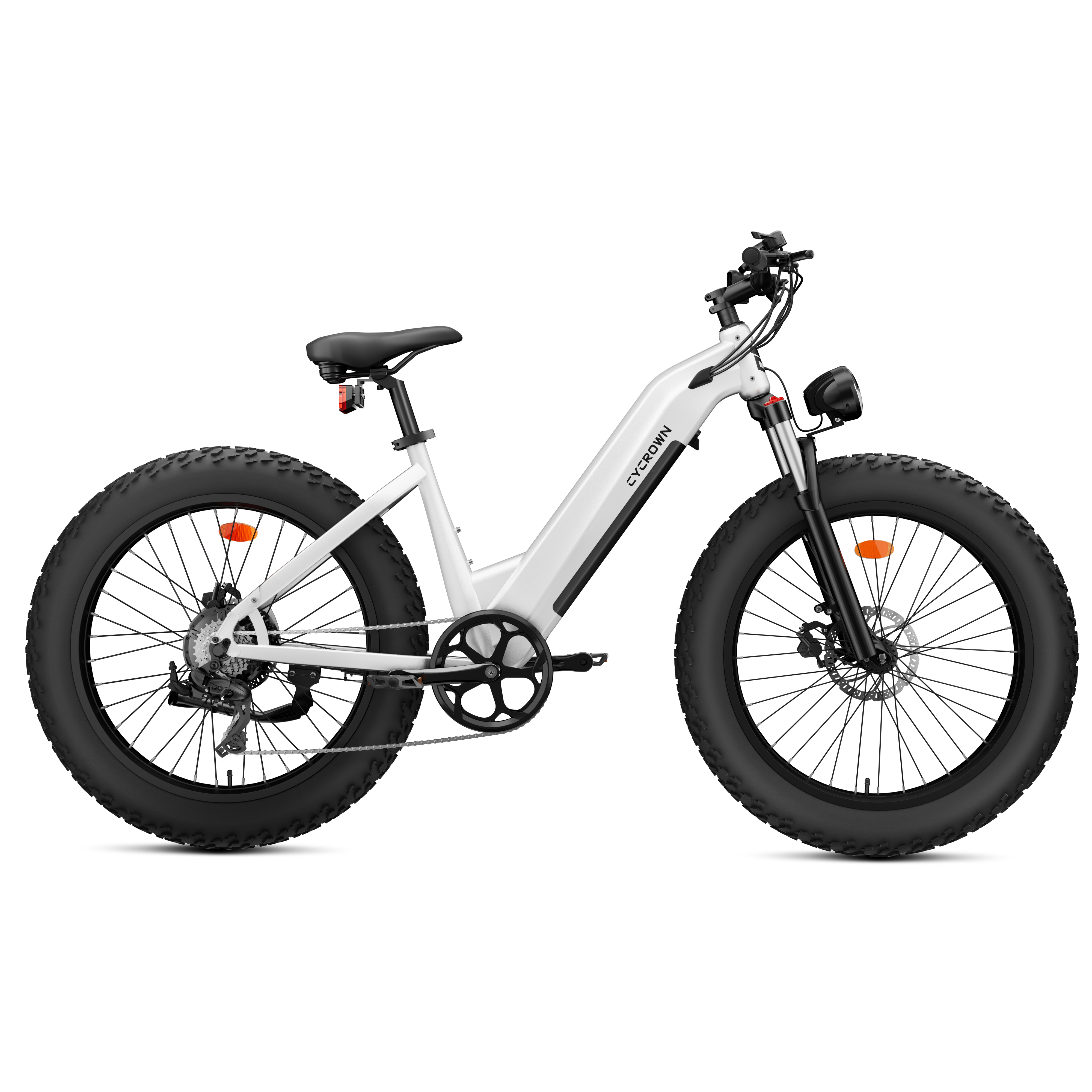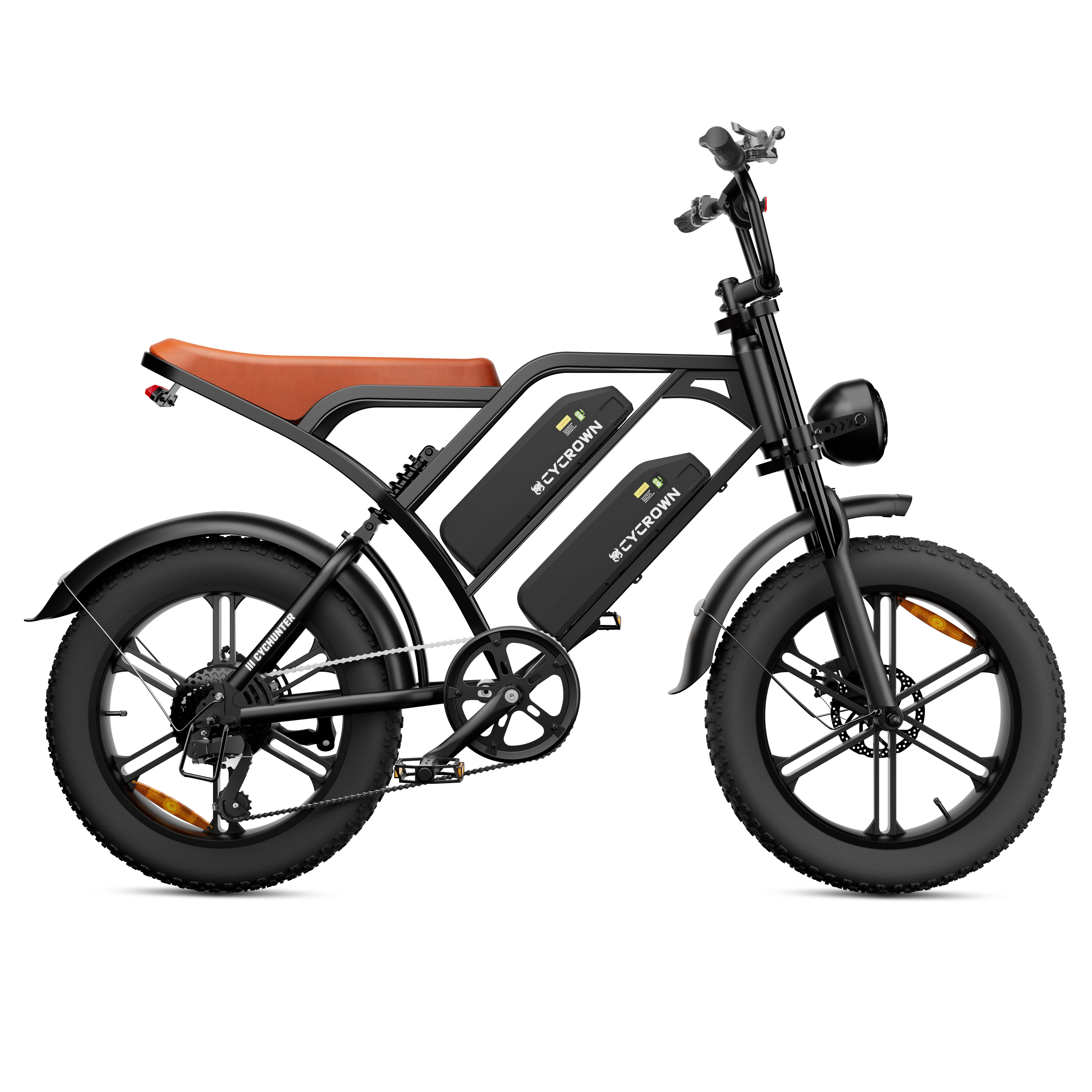Fat tire bikes, as the name suggests, are bicycles with oversized tires. This concept originated with French cyclist Jean Naud in the 1980s. During a trek through the Sahara desert, Naud encountered the need for tires capable of navigating the treacherous sands safely.
Drawing inspiration from Mountain Goat Bikes' pioneering inflatable tires crafted for off-road mountain biking, Naud devised his version, aptly named the "Fat Tire."
Despite their inception decades ago, fat tire bikes saw a resurgence in popularity only in recent years. Their newfound acclaim can be attributed to their versatility and durability. Renowned for their capacity to tackle diverse terrains and adverse conditions, fat tire bikes have become the go-to choice for many cyclists. This blog will delve into fat tire electric bikes, unraveling their features, advantages, and considerations.
Fat Tire Electric Bike Specifications
Most fat tire bikes are 4” wide, but some can be 4.5” or even 4.8”, often referred to as super fat tires. Conversely, conventional bike tire widths range from 1.95” to 3.0".
Unlike traditional tires, fat tires can be ridden at varying pressures, measured in pounds per square inch (psi). Most fat tires can be inflated from 5 psi to 30 psi, allowing you to adjust the tire pressure to suit different surface conditions. While a 30 psi tire works best on paved roads, lowering the psi improves surface contact and provides better floatation on soft surfaces such as wet sand or snow.
Fat bikes come in many shapes, sizes, and types, including step-through frames, foldable electric frames, and perhaps the most common, fat tire electric mountain bikes. The key variable between these types is the tire width.
Larger rims and wider tires typically add about 4 pounds to the bike's weight. Though 4 additional pounds may not sound like much, it's on top of the added weight of the motor and battery. As such, fat tire e-bikes are generally heavier than other e-bikes and certainly heavier than traditional bikes.
What Are the Benefits of Fat Tire Electric Bikes?
Fat tire e-bikes have become popular for their numerous benefits. Here are the top advantages:
All-Terrain Capability
The oversized tires on fat-tire e-bikes expand the range of terrain you can conquer. These extra-wide tires significantly enhance balance and stability on tricky surfaces like mud, sand, and snow. This means you can now stick a pin on a map and ride virtually anywhere.

Shop Now: CycUltra Off-Road Electric Bike
For example, the CycUltra Off-Road Electric Bike boasts a resilient 26"×4" fat tire designed for optimum traction and grip. This formidable companion empowers you to conquer numerous landscapes, from muddy trails and snowy mountain paths to dusty and bumpy routes, and dunes. With fat tire bikes, the joy of riding on two wheels knows no bounds.
Resilience to Any Weather Condition
A key difference between fat-tire and traditional-tire e-bikes is their ability to handle various weather conditions. Adverse conditions can impact the performance of regular tires, causing them to bog down in mud or skid in heavy rain. However, fat tires are designed to tackle all sorts of weather. Whether it's a heavy downpour, snow, or thick mud, a fat-tire e-bike will deliver optimal levels of balance and control.
Guaranteed Comfort
The extra rubber on fat-tire e-bikes ensures a comfortable ride by absorbing shocks and vibrations. These tires offer added comfort and ease on long stretches of road as well as rugged or bumpy trails. Additionally, the larger tires provide greater stability, helping even new riders feel more confident on two wheels, regardless of the surface condition.
Maximum Versatility
Fat-tire e-bikes excel in both adverse conditions and on smooth roads and paved paths. This versatility makes them an excellent all-around option. Heavy-duty fat tires provide the same level of comfort and stability whether commuting to work or cruising around town, making these bikes ideal for all purposes.
Durability
Top-quality fat-tire e-bikes are built to last, reducing the likelihood of encountering maintenance problems. This durability is a significant advantage over standard tires, which are more prone to punctures and flat tires on rough terrain or potholes.
Are There Any Downsides to Fat Tire E-Bikes?
Fat tire electric bikes have several disadvantages that you should consider before purchasing one.
More Expensive
Fat-tire electric bikes may come with a slightly higher price tag compared to conventional bikes. Finding a high-quality electric bike within the $1,500 to $3,000 range requires thorough research.

Show Now: CycVerve Electric Bike
Thankfully, our CycVerve Electric Bike, typically priced at $1,299.99, stands out as one of the most budget-friendly options in the 26"x4" fat tire category. During our limited-time presale event, you can grab it for just $999.99. Despite its affordability, the CycVerve doesn't compromise on quality, offering a blend of safety, comfort, and style in one sleek package.
Increased Weight
Fat tire bikes are generally heavier than their conventional counterparts, especially when designed as heavy-duty mountain bikes. They can weigh anywhere from 60 to 80 lbs, compared to regular e-bikes, which typically weigh 45 to 60 lbs. The added weight comes from the larger tires and rims, and in the case of mountain bikes, the heavier gauge frame and components.
Slower and Sluggish
The combination of heavier frames, decreased tire pressure, and increased rolling resistance can make fat tire bikes feel slower and more sluggish compared to other models. While the motor helps mitigate this issue, it can still be noticeable if you’re only using the standard gears, especially on uneven surfaces or hills.
Less Grip in Certain Condition
Fat tire bikes excel in floatation over soft surfaces like sand and snow. However, in certain muddy conditions, you might find yourself with less grip or bite compared to narrower tires. This can be particularly tricky on gravelly surfaces, where the larger contact area might become destabilized by small rocks acting like ball bearings, reducing friction.
Final Words
While fat tire electric bikes offer numerous advantages over regular e-bikes, there are a few considerations to keep in mind before making a purchase. Conducting thorough research will help you make a well-informed decision.










